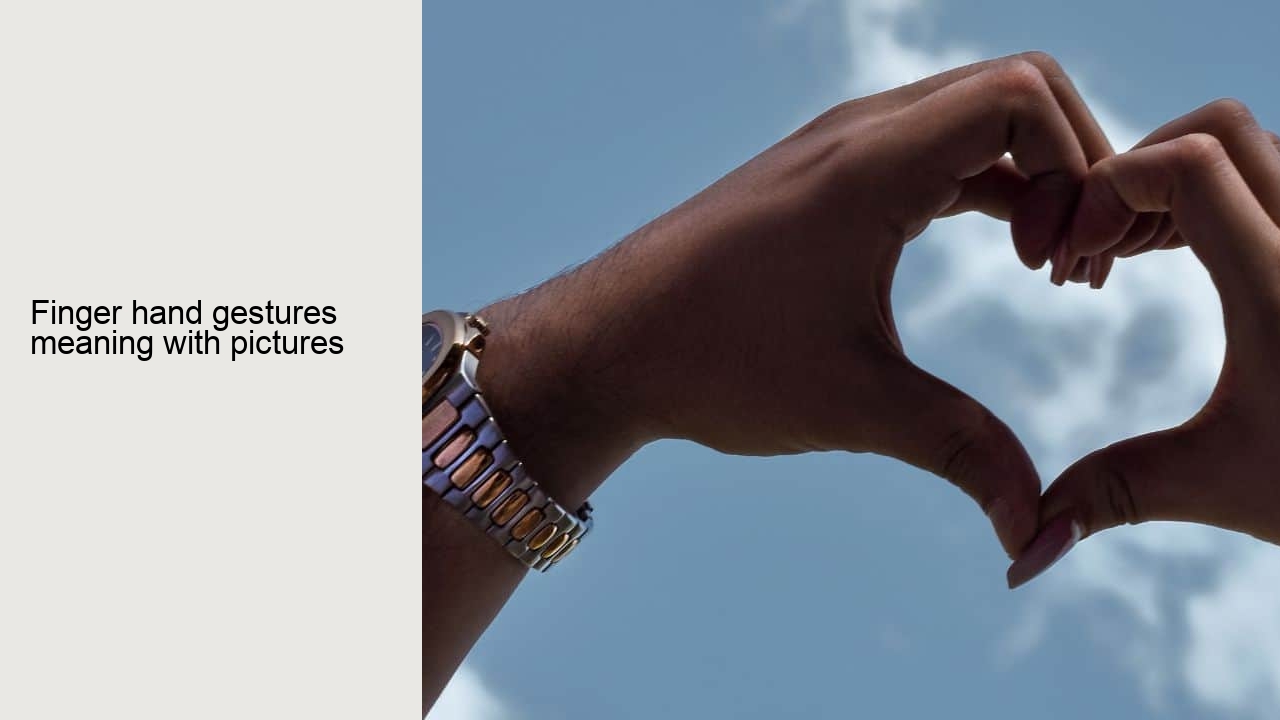
The "mano cornuta" or "horned hand" gesture, made by holding up the index and little fingers in a V shape, is often associated with rock music and is used to indicate "rock on" or to show support for the band.
The peace sign is made by holding up the index and middle fingers in a V shape, and it is often used as a symbol of peace or as a greeting. The peace sign is widely recognized and understood in most cultures, making it a useful tool for communication in a variety of settings.
The "Come here" gesture is made by holding the hand up with the palm facing out, and moving the fingers in a come-hither motion. This gesture is used to indicate that you want someone to come closer, or to indicate that you are coming closer to someone. This gesture is often used in situations where you want to indicate your location or to indicate that you want someone to approach.
In conclusion, hand gestures are a subtle yet powerful form of nonverbal communication that can convey a wide range of emotions, thoughts, and intentions. From the simple wave to the complex "stop" gesture, hand gestures can be used to add emphasis to verbal language, clarify meaning, and establish connections with others. It's important to note that hand gestures can vary in meaning depending on the culture and context they are used in, so it's always best to be aware of the cultural nuances before using a specific hand gesture in a particular setting. By understanding the various hand gestures and the meanings they convey, we can improve our communication skills and build stronger relationships with others.
The "rock on" hand sign, which is made by holding up the index and pinky fingers while keeping the other fingers curled down, is often used among teens to indicate rock music, support or agreement.

In conclusion, hand gestures are a rich and complex form of communication that convey meaning in various cultures and contexts. They range from simple gestures like a wave or a thumbs up to more complex gestures like sign language. Each gesture has its own nuances and subtleties that make them fascinating and versatile tools for human communication. Whether you are trying to express emotions, convey instructions, or tell a story, hand gestures are an essential part of the human experience.
The fist is a powerful hand gesture that is often associated with strength and determination. It is used to indicate power, aggression, or to show support for a cause. It is also used as a symbol of resistance and protest.
Another common hand gesture is the thumbs up. This gesture is generally used to indicate agreement, approval or to show that everything is okay. The thumbs up is a universal sign that is understood in many cultures and is often used in the context of social media and instant messaging.
The "west side" hand sign, which is made by holding up the index and pinky fingers while keeping the other fingers curled down, is often used among teens to indicate gang affiliation.
The "four" hand sign is an enigmatic hand gesture that is often associated with the practice of occultism and esotericism. The sign is made by holding up four fingers while keeping the thumb tucked in, and is often used as a symbol of power, strength and protection.
The fist bump is another popular hand gesture that is used to indicate camaraderie or to show support. This gesture is often used among friends, teammates, and colleagues to show solidarity and shared purpose.

The peace sign is a hand gesture that is made by holding up the index and middle fingers in the shape of a "V." This gesture is often used to indicate peace or to make a peace sign. It is also used as a way of saying "victory" or "goodbye."
First, let's start with the most basic hand gesture: the wave. A wave is a simple gesture that is used to greet or acknowledge someone. It can be done with one hand or both hands and can vary in intensity, from a casual, lazy wave to a more enthusiastic, vigorous wave.
Holding up four fingers in pictures is a symbol of solidarity and unity among athletes. It is often used to represent the "four pillars" of sportsmanship: physical, mental, emotional, and spiritual. By holding up four fingers, athletes are expressing that they are not just strong in their physical abilities, but also in their mental and emotional fortitude, and their spiritual dedication to their sport. This gesture is a reminder that true success in athletics is not just about winning, but about the holistic development of the individual.
Holding up one finger can hold different meanings depending on the context and culture. In American Sign Language, it represents the number one. In some sports, it's a sign of a referral to the video assistant referee. Additionally, it can be used as a symbol of singularity or unity, as in the phrase "one for all, and all for one." On the other hand, it can also be considered as an offensive gesture in some cultures, as it can be interpreted as an expression of dominance or superiority. As with any hand gesture, the meaning can vary and it's important to be aware of the context and cultural implications before using this gesture.
Holding up three fingers can hold different meanings depending on the context and culture. In some countries like Thailand, it's a symbol of respect and admiration towards the royal family. In the Hunger Games series, it's a sign of rebellion and resistance against the oppressive government. In American Sign Language, it represents the number three. In some sports, it's a sign of a referral to the video assistant referee. Additionally, it can be used as a symbol of something being a trinity, or of something being divided into three parts. As with any hand gesture, the meaning can vary and it's important to be aware of the context and cultural implications before using this gesture.